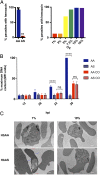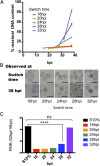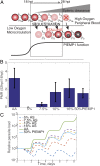Resistance to Plasmodium falciparum in sickle cell trait erythrocytes is driven by oxygen-dependent growth inhibition
- PMID: 29946035
- PMCID: PMC6048551
- DOI: 10.1073/pnas.1804388115
Resistance to Plasmodium falciparum in sickle cell trait erythrocytes is driven by oxygen-dependent growth inhibition
Abstract
Sickle cell trait (AS) confers partial protection against lethal Plasmodium falciparum malaria. Multiple mechanisms for this have been proposed, with a recent focus on aberrant cytoadherence of parasite-infected red blood cells (RBCs). Here we investigate the mechanistic basis of AS protection through detailed temporal mapping. We find that parasites in AS RBCs maintained at low oxygen concentrations stall at a specific stage in the middle of intracellular growth before DNA replication. We demonstrate that polymerization of sickle hemoglobin (HbS) is responsible for this growth arrest of intraerythrocytic P. falciparum parasites, with normal hemoglobin digestion and growth restored in the presence of carbon monoxide, a gaseous antisickling agent. Modeling of growth inhibition and sequestration revealed that HbS polymerization-induced growth inhibition following cytoadherence is the critical driver of the reduced parasite densities observed in malaria infections of individuals with AS. We conclude that the protective effect of AS derives largely from effective sequestration of infected RBCs into the hypoxic microcirculation.
Keywords: Plasmodium falciparum; malaria; oxygen; red blood cell; sickle hemoglobin.
Conflict of interest statement
The authors declare no conflict of interest.
Figures





References
-
- Haldane JBS. The rate of mutation of human genes. Hereditas. 1949;35:267–273.
Publication types
MeSH terms
Substances
Grants and funding
LinkOut - more resources
Full Text Sources
Other Literature Sources
Research Materials

